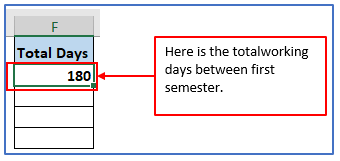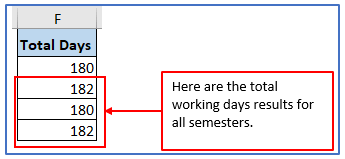Calculate Workdays in Excel with ease, ensuring accurate project schedules and efficient leave tracking. Harness the power of this function to streamline your work and enhance productivity. Say goodbye to manual calculations and embrace the convenience of Excel’s Workday function. Whether you’re managing project timelines or tracking employee absences, this Excel feature simplifies the process, making it an essential tool for professionals in various fields. Start using Calculate Workdays in Excel today to save time, reduce errors, and keep your projects and workforce on track.
The calculation method utilizes the number of complete business days gone by between two dates, without taking into account specific weekends and holidays.
- What is work Day function in Excel?
- How to get total days between two dates?
- How to use SUM and INT Functions?
- Working Days between dates excluding holidays.
- How to apply NETWORKDAYS.INTL Function with Custom Holidays for calculating workdays.
- Some mistakes when using Workday function in Excel.
1. What is work Day function in Excel?
Workday, an Excel-based tool for managing work and deadlines, is a powerful instrument used in business applications as well as project management. Taking into account specific weekends and holidays, it can be an effective means of keeping track of deadlines. By entering a start date, number of days, and a list of holidays, the Work Days feature automatically calculates the expected end date. This feature is particularly beneficial in industries with irregular work schedules or complicated schedule. By focusing on planning processes in Excel, the Workday feature delivers efficient and accurate results. To determine the days on a non-business basis, use the Business Days function in Excel for next time.
How to get total days between two dates?
Workday, an Excel-based tool for managing work and deadlines, is a powerful instrument used in business applications as well as project management. Taking into account specific weekends and holidays, it can be an effective means of keeping track of deadlines. By entering a start date, number of days, and a list of holidays, the Work Days feature automatically calculates the expected end date.
2. How to get total days between two dates?
Step 1: Here is an example of students semester schedule for a University and are required to calculate the total working days for the staff in each semester. A complete semester is measured by the days between the first day of the semester (start date) to the last day (end-date). Create a data table with the information below.
Placed the information here.

Step 2: Add another column in F1:F5 to get the Total days there.
Added the column here.

Step 3: Now, insert the formula in the box. The formula is: =D3-C3
Applied the formula below.

Step 4: This feature is particularly beneficial in industries with irregular work schedules or complicated schedules. Press Enter and the Total days will come out.
D3-C3 gives the total days between the two dates. Here is the total working day’s result below.

Step 5: Now, use the same for the rest of the semesters, changing with the column range.
Every semester total working days are here.
Here are the total working days results for all semesters.

3. How to use SUM and INT Functions?
By using the SUM and WEEKDAY functions, you can find out how many business days are between two dates.
Step 1: Enter some information as shown below.
Entered the data’s into the Excel sheet.

Step 2: Now, add the column from F2:F6 to get the SUM and INT Functions result there.
The column has been added here.

Step 3: Added to WEEKDAY result and divided by 7, resulting in decimal form. By using the SUM and INT functions, only the integer part will be added because the nearest integer is used to round off each decimal. The Formula is: =SUM(INT((WEEKDAY(C3-{2,3,4,5,6})+D3-C3)/7))
Used the formula here.

Step 4: Click the enter to get the result.
Here you can see the result after clicking enter.

Step 5: Now, use the same for the rest of the semesters, changing with the column range.
For, Year 1(Second semester) the formula will be: =SUM(INT((WEEKDAY(C4-{2,3,4,5,6})+D4-C4)/7))
For, Year 2(First semester) the formula will be: =SUM(INT((WEEKDAY(C5-{2,3,4,5,6})+D5-C5)/7))
For, Year 2(Second semester) the formula will be: =SUM(INT((WEEKDAY(C6-{2,3,4,5,6})+D6-C6)/7))
Here are all the results of SUM and INT Functions.

4. Working Days between dates excluding holidays.
Only the start date and end date are available for use in NETWORKDAYS function. Counting the days between two dates, it only needs to find how many days have passed Sunday instead of Saturday.
Step 1: First, make some data and put it into Excel as shown in the example.
All the data has been placed here.

Step 2: Now, add the column from F2:F6 to get the SUM and INT Functions result there.
The column has been added here.

Step 3: Now, insert the formula. The formula is: =NETWORKDAYS(C3,D3)
Applied the formula in the below image.

Step 4: Now, press Enter.
Here is the excluding holidays result after applying the formula.

Step 5: Now, use the same for the rest of the semesters, changing with the column range.
For, Year 1(Second semester) the formula will be: =NETWORKDAYS(C4,D4)
For, Year 2(First semester) the formula will be: =NETWORKDAYS(C5,D5)
For, Year 2(Second semester) the formula will be: =NETWORKDAYS(C6,D6)
Here are the Working Days results between dates excluding holidays.

5. How to apply NETWORKDAYS.INTL Function with Custom Holidays for calculating workdays?
The function NETWORKDAYS.INTL has code to treat weekends as Friday and Sunday. It is necessary to use 7 digits, each of which represents the day of reference in the year, beginning with Monday. Therefore, Sunday and Friday are the last and penultimate days.
Step 1: Make a data table first.
All the data has been entered here.

Step 2: Now, add the column from F2:F6 to get the SUM and INT Functions result there.
The column has been added here.

Step 3: Now, insert the formula. The formula is: =NETWORKDAYS.INTL(C3,D3,”0000101″)
The code looks like “0000101”. Here, 0 is a working day, 1 is a non-working day.
The formula is entered.

Step 4: After applying the formula click on enter.
Here is the result below:

Step 5: Use the same formula for another year and semesters and change the column number according to the columns or drag down the Excel cursor from F2 and you will get the result of Here are the results.

6. Some mistakes when using Workday functions in Excel.
One of the most frequent errors occurs when using Excel’s WORKDAY function. Check for errors:
Incorrect syntax: Ensuring that the formula containing the start date, number of days and holidays is entered correctly.
Missing holiday parameter: Always include the holiday parameter to accurately calculate working days, especially if holidays are relevant to the calculation.
Using non-working days: The function does not take into account weekends, so be sure to use valid working days in your calculations.
Holiday list not updated: If the holiday list changes, remember to update it within the WORKDAY function to ensure accuracy.
Error messages are ignored: Be careful with error messages that Excel displays.
It may help identify and resolve the issue.
#NAME? Error.
Workday functions in Excel will fail if the function does not recognize the specified name or reference. This error is often caused by typos, missing quotes, or incorrect cell references. This error can be corrected by examining the function syntax and verifying that all names and references are correct. Examine for any errors or omissions of quotation marks. Also, ensure that all referenced or named ranges are properly defined within the workbook. By troubleshooting these issues, you can resolve your #NAME? issue removes. Troubleshoot and successfully use Workday functions in Excel.
#Value! Error.
Errors in Workday functions can be caused by incorrect input arguments or incompatible data types. To address this issue, ensure that the date or valid date value is used when indicating the start date and number of days. Also, double-check the function syntax to make sure there are no missing commas, quotes, or parentheses, or any extra ones. If the error persists, consider using the DATE function to create a valid date or resolve the cause of the incorrect input. By addressing these issues, #VALUE! can be avoided. Troubleshoot Workday functions in Excel and use them correctly.
Application of Calculate Workdays in Excel
- Project Planning: Calculate workdays to determine project durations, taking into account weekends and holidays. This helps in setting realistic timelines for deliverables.
- Leave Management: Track employee leave by calculating workdays for accurate leave balances, ensuring smooth HR operations.
- Service Level Agreements (SLAs): Use workday calculations to measure compliance with SLAs, ensuring timely service delivery.
- Financial Projections: Calculate workdays for interest and payment schedules, essential for financial planning and loan calculations.
- Inventory Management: Determine lead times and reorder points by considering workdays, helping in efficient inventory management.
- Event Planning: When organizing events or conferences, use workday calculations to schedule activities and allocate resources effectively.
The “Calculate Workdays” function simplifies these tasks by automatically excluding non-working days from calculations, making it a valuable tool for various applications.
For ready-to-use Dashboard Templates:
